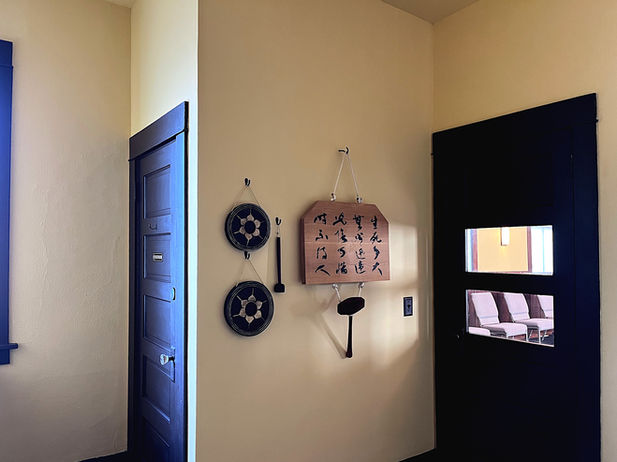
Visiting Our Temple
Parking
We ask that visitors do not park in front of the apartment complexes across the street or to the west of the temple.
Bus Routes
TriMet buses run up and down NE MLK Jr. Blvd. Our main cross streets are NE Alberta St. and NE Killingsworth St.
Bikes
We are located on the NE Rodney Ave neighborhood greenway. Bike racks are available in front of our temple.

A Note About Forms
Forms in Zen serve an important purpose. From the moment we enter the Zendo, we are inviting our mind to rest and relax in a state of respectful serenity and ease. Our lives and minds are so cluttered with the myriad fascinations avaialble to us that there is something reassuring, familiar and safe when returning, week after week, to these familiar rituals. Though some will balk when first learning them, especially during long retreats when the forms are maintained for days on end, the forms become companions in practice, helping to balance mind and body and softening the constricted sense of self. I often say, "At first, I had to squeeze myself into the forms. Then I rested into forms. Now, I become them." The forms in the zendo can be held lightly and with a sense of ease, play and beauty. Done with grace, they become a nicely choreographed dance into which our life is simplified and our minds put at peace. Finally, I want to reassure anyone nervous about the forms that there is plenty of time to learn them, that we all often do them "wrong," and that, in the end, there is a simple and effortless sense of rightness associated with them. -Rinzan Osho
Zazen
Seated meditation is the most foundational form in Zen practice. We sit with three points of contact on the floor. Our two knees (or feet if sitting in a chair) and tail bone form a tripod from which we can feel firmly rooted to the ground while we hold our spine erect and open our awareness in all directions. We then focus the breath in the hara (the space just below the navel), yet feeling the expansive of the breath in each cell of our body.
Entering the Zendo
We enter the zendo from the downstairs entrance of the temple. Inside is a place where you can remove your shoes and leave your belongings. The downstairs door is locked during zazen. So items are safe. If you arrive late, you may enter through the main entry upstairs. If this is your first time, you'll be met by a host who will show you around and offer meditation instruction. Whenever entering or existing the zendo, it is traditional to bow (hands palm to palm in gassho) first to the icon of Kanon, just inside the zendo door to the right. Then proceed to your row. Bow at the head of the row. Walk to the cushion, bench or chair you would like to sit at, offer a standing bow to the altar and then to the community. Take whatever seated position is most comfortable and supportive. Traditionally, we are all in seiza (on our knees) for the opening tea service. All of this indicates the seriousness with which you approach your practice and prepare for zazen. While entering the zendo with seriousness, one is encouraged not to become glum. Rather, we can have a light and graceful attitude while coming to practice.
Chanting and Bowing
Our chanting is in Sino-Japanese, with chant cards to help you follow along. The syllables make no sense to most of us, but the point is to be fully engaged with the mind not captured by the meaning of the words. Chanting with powerful awareness from the core of our body (hara) helps develop and prepare the Zen mind. Each service includes three full prostrations (sanpai) which will be illustrated to beginners (or you can simply copy others). This gesture is not one of subservience but of humility and appreciation, lowering the ego-mind to elevate the Buddha-mind. If one is unable to prostrate due to knee or back problems, it is acceptable to offer a standing bow.







